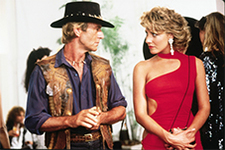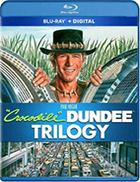Crocodile Dundee
|  Prior to Crocodile Dundee becoming an international critical and commercial smash hit in the fall of 1986, most Americans had little or no idea who Paul Hogan was. Such was not the case in his native country, where Hogan—or, “Our Hoges,” as he was known—had been a fixture of Australian media since the early 1970s. He was first discovered on the talent show New Faces, which he spun into a headlining gig on the eponymous The Paul Hogan Show, a sketch comedy series that ran for 12 seasons from 1973 and 1984. He appeared in a major role in the 1985 Australian mini-series Anzacs, which dramatized the lives of Australian and New Zealand army soldiers during World War I. It proved he could do more than sketch and stand-up comedy, but it was still no guarantee that he could headline a major film. Crocodile Dundee, which was financed independently through public subscription and government tax breaks, changed all that. In becoming the highest grossing film in Australian history and the second highest grossing film at the U.S. box office in 1986, it launched Hogan (who also co-wrote and co-produced the film) from being a favorite Australian media personality into being an international icon. The film, which Hogan wrote with Ken Shadie and John Cornell, both veterans of The Paul Hogan Show, was an inspired bit of fish-out-water comedy that mined well-worn stereotypes about tough, resilient Australian “battlers” and callous, materialistic New Yorkers. It is a preeminent comedy of culture clash, updating the popular “ocker comedies” of the 1970s (which featured amiable, but uncouth and uncultivated Australian protagonists) with more polish and less outright vulgarity. And, even though certain elements of it have not dated all that well (the cocaine jokes, the giggly prostitutes, and especially the multiple grope-the-transvestite gags), the essence of the film still works marvelously, especially because Hogan imbues Dundee with a real sense of heart and decency, which keeps him from turning into a simplistic cartoon of macho-Australian signifiers. As Hogan put it in an interview with The New York Times, “Crocodile Dundee never loses his dignity. Even if he is naive and uneducated, he doesn’t make a melon of himself all the time. He’s got some grace.” Although often described as a “fish-out-water comedy” (see my own words above), Crocodile Dundee is actually two fish-out-of-water comedies—a double-feature of sorts—first with a New Yorker in the Outback and the second with a bushman in New York. The film opens in Australia, with the arrival of seasoned Big Apple journalist Sue Charlton (Linda Kozlowski) in the aptly named Walkabout Creek in the Northern Territory. She is there to do a story on Michael J. “Crocodile” Dundee (Hogan), a local bushman and safari guide who survived a vicious crocodile attack that may or may not have been greatly exaggerated. Sue first meets with Dundee’s business partner, the genial and awkward Walter Reilly (John Meillon), before meeting the man himself, who promises to take her cross-country to show her where the attack occurred and retrace the path he used to drag himself back to civilization. From the very beginning Dundee is casually honest about the merging of myth and reality, admitting that his nickname was given to him by Walter to make him seem more interesting to the tourists. Sue, the epitome of the wealthy city girl, is far out of place, but she has Dundee to protect her, guide her, and show her both the beauty and the dangers of the rugged Outback, which is beautifully captured by cinematographer Russell Boyd, who had previously shot Peter Weir’s Australian New Wave classics Picnic at Hanging Rock (1975) and Gallipoli (1981). Not surprisingly, some romance starts to bloom, especially after Dundee saves Sue from (what else?) a crocodile attack, despite the fact that she is involved with her supercilious yuppie editor, Richard (Mark Blum). When it is time for her to return to New York, Sue alights on the idea of bringing Dundee back with her. It will make a great capstone to her story, of course, but we also suspect that she just doesn’t want to be away from him. So, to the big city goes the rugged bushman, complete with his snakeskin jacket and tooth-encrusted hat. Dundee, who has never been out of the tiny burg of Walkabout Creek, is now the one out of place, although he is so friendly, so amiable, and so downright charming in his own weathered way that he wins over pretty much everyone he comes into contact with (Richard notwithstanding, of course). Dundee must learn to navigate crowded city streets, Warhol-esque cocktail parties, taxicabs, bidets, and high-end restaurants. He remains resolutely true to who he is, although the plot is sometimes a bit contrived in terms of what he knows and what he is naively unaware of, the latter of which is generally sexual in nature (the aforementioned prostitutes and transvestites), although he also automatically assumes that his black limo driver (Reginald Veljohnson) is a member of a tribe like the Aboriginals back home who raised him. If Hogan hadn’t made Dundee into such an affable character, it would all feel depressingly formulaic. The underappreciated musical score by Peter Best, which slides effortlessly from robust, jaunty themes, to mystical romanticism, does a lot of heavy lifting, as well, in helping the film smoothly shift gears from slapstick, to culture-clash comedy, to romance. One of the film’s best scenes, in which Sue must relay crucial information to Dundee across a crowded subway platform, merges the comic and the romantic in the best possible way. It is no wonder the film became such a huge hit both here and Down Under. This was a shining moment for Hogan, enhanced by the fact that the previous year he had been named “Australian of the Year,” an annual award conferred by the National Australia Day Council, making him only the second actor so honored since the award was first given in 1960. And yet, Hogan’s association with Dundee was so strong that he was never able to fully shake it, and it ended up defining the rest of his career, which included two diminishing sequels (1988’s Crocodile Dundee II and 2001’s Crocodile Dundee in Los Angeles), a long-running Subaru Outback ad campaign in which he played a variation on the character, and various cameo appearances, including one in the popular 2018 Australian tourism ad campaign that was cleverly disguised as a faux sequel with Danny McBride playing Dundee’s son. Hogan had a few starring vehicles in the 1990s, including the comedy Almost an Angel (1990) and the Western Lightning Jack (1994), both of which he also wrote, but he was never able to shake Dundee’s shadow. For better or worse, the “Crocodile Man” would be his greatest legacy.
Copyright © 2021 James Kendrick Thoughts? E-mail James Kendrick All images copyright © Paramount Home Entertainment | |||||||||||||||||||||||||||||
Overall Rating: 

 (3)
(3)


